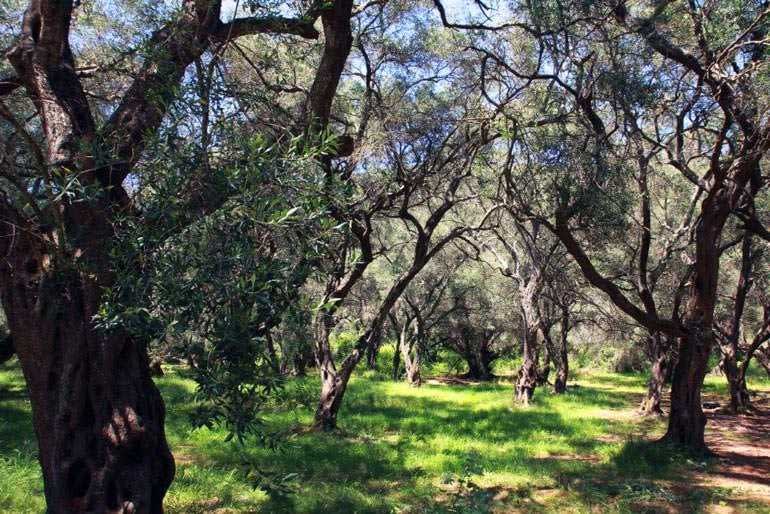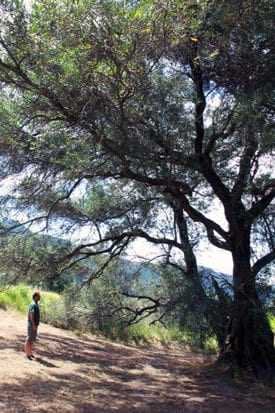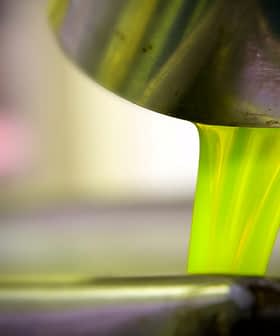
Corfu has been known as a Mediterranean tourist destination for decades but it has not been particularly known for producing exceptional olive oil. That could be changing.
Spyros Dafnis, a recent University of Economics graduate whose family owns an olive mill in Corfu decided to try a new method of harvesting and milling the olives to see if he could get better results.
The main varietal is called Lianolia and is found almost exclusively in Corfu. Lianolia grows exceptionally tall sometimes reaching 18 meters (59 feet), making it very difficult to harvest the olives early. Farmers usually wait until late in the season when the olives practically fall on their own onto nets laid on the ground.
Dafnis explained what motivated him and his family to break with centuries of tradition of how olives were harvested and milled.
“Our idea was born amid the crisis in our country in recent years. As an antidote to the crisis, we embraced the “revolution.” A revolution of creativity, innovation and knowledge. For this to happen we needed to think alternatively and act unconventionally.

We saw around us a natural wealth left at the mercy of tradition which resulted in a product that dishonoured itself by not realizing its full potential. So we decided to pursue our dream by breaking the tradition that our island could not produce high quality olive oil.”
Mr. Dafnis and his brother Giorgos, together with the enthusiastic support of their family, studied research papers on olive oils containing high phenolic levels. They decided to abandon the traditional method of harvesting with the goal of producing a premium high phenolic EVOO.
It was a gamble. They acquired a mechanical shaker in order to begin the harvest in mid-October, they lowered the temperature during the malaxation phase, eliminated the use of water and the use of a centrifuge. They had their EVOO tested using the new Nuclear Magnetic Resonance (NMR) method recently developed by Dr. Prokopios Magiatis at the National and Kapodistrian University of Athens.
Their EVOO made exclusively from Lianolia varietal contained the highest levels of phenolic compounds ever recorded in Greece.
They expected the olive oil to be good, but did not imagine it would be this exceptional:
Oleocanthal: 680 mg/Κg
Oleacein: 350 mg/Kg
Oleuropein aglycon: 53mg/Kg
Ligstroside aglycon: 58mg/Kg
Over 1 gram of phenolic compounds per kilo (total 1141 mg/Kg)
Within two years of dedicated study and application the Dafnis family has put Corfu and the Lianolia variety firmly on the world olive oil map.

In anticipation of a positive result they also created an olive bottle design and a brand name. Their brand, “The Governor.” (The name was inspired by Ioannis Kapodistrias who was born in Corfu and was the first elected head of state or “The Governor” of newly-liberated Greece in 1828. He was known as a reformer and educator who built the first university in modern Greece where, coincidentally, the NMR method was invented.)
The Governor was awarded Golden Star at the Great Taste Awards and the silver medal at a competition in Japan this year.
Producing an EVOO that combines extremely high phenolic content with award winning taste is not an easy task. Spyros and family are intent on continuing their experiments and sharing they knowledge they have gained with other olive growers from Corfu and around the world.
The origin of the Lianolia variety found almost exclusively on Corfu is said to have been brought to the Island during the Venetian rule of Corfu about 500 years ago. Its true origin is shrouded in mystery.
Homer mentions Corfu in The Odyssey as having olive trees. This was thousands of years before Venetian rule. How and why did the local varieties disappear?
Perhaps now there will be a renewed scientific interest to discover where the Lianolia olive originated.








